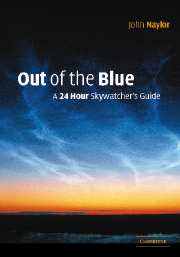Book contents
- Frontmatter
- Contents
- Preface
- Introduction
- 1 Daylight
- 2 Shadows
- 3 Mirages
- 4 Sunset and sunrise
- 5 Rainbows
- 6 Coronae and glories
- 7 Atmospheric halos
- 8 The night sky
- 9 The Moon
- 10 Eclipses
- 11 Planets
- 12 Stars
- 13 Comets and meteors
- APPENDIX: Technical and practical advice for skygazing
- Glossary
- Further reading
- Sources and notes
- Index
- Frontmatter
- Contents
- Preface
- Introduction
- 1 Daylight
- 2 Shadows
- 3 Mirages
- 4 Sunset and sunrise
- 5 Rainbows
- 6 Coronae and glories
- 7 Atmospheric halos
- 8 The night sky
- 9 The Moon
- 10 Eclipses
- 11 Planets
- 12 Stars
- 13 Comets and meteors
- APPENDIX: Technical and practical advice for skygazing
- Glossary
- Further reading
- Sources and notes
- Index
Summary
Among the many self-luminous moving suns, erroneously called fixed stars, which constitute our cosmical island, our own Sun is the only one known by direct observation to be a central body in its relations to spherical agglomerations of matter directly depending upon and revolving around it, either in the form of planets, comets or äerolite asteroids.
Alexander von Humbolt, Cosmos, Vol. 1, 1845; reprinted John Hopkins University Press, 1997, p. 89The Solar System
For most people, mention of the Solar System probably conjures up that well-known image of nine concentric circles, each representing the orbit of a planet, all more-or-less centred on the Sun. In fact, this image is presented from a vantage-point that no human has ever occupied, somewhere far outside the Solar System. From such a distance, the only thing that you would see of the Solar System is the Sun, reduced to an extremely bright point of light. Without a telescope you would be unable to see Jupiter, the largest planet, let alone any of the other planets. The fact is, by any objective measure, such as mass, diameter or brightness, planets are insignificant motes compared with stars. Yet, what would the Solar System be without planets? Planets loom large in our view of the cosmos for several reasons, not the least of which is that we happen to inhabit one of them.
- Type
- Chapter
- Information
- Out of the BlueA 24-Hour Skywatcher's Guide, pp. 240 - 257Publisher: Cambridge University PressPrint publication year: 2002

